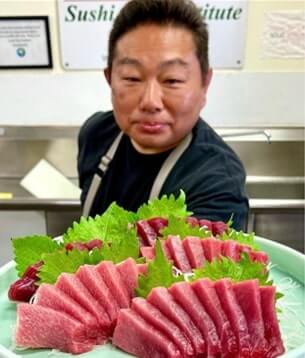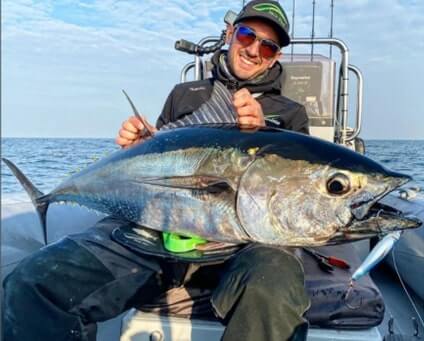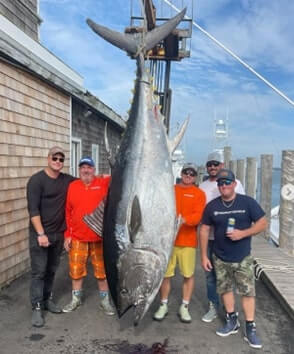Wanna know which is the most expensive fish in Japan? The bluefin tuna is actually the most expensive fish in Japan. But how expensive is it really? Read on to find out!
Have you heard about the bluefin tuna fish? It may share a name with canned tuna but they’re nothing close to each other in pricing.
No, I’m not talking about a difference of a few hundred dollars. More like a million actually. Bluefin tuna fish is like the Rolls Royce of the seafood world.
Let’s find out more about the most expensive fish in Japan and how much people are willing to pay for it!
- Related: Most Popular Types Of Fish Consumed In Japan
- Related: Why Japanese Eat Raw Fish And Love It!
Most Expensive Fish In Japan
Bluefin tuna is the most expensive fish in Japan and just a pound of bluefin tuna sells for upwards of $40 in Japan!
Bluefin tuna is so sought after that overfishing has become a serious concern over the past few years. A 15-year recovery plan had to be implemented in 2007. Among other amendments, this plan increased the minimum size of the bluefin tuna caught to 66 pounds.
Bluefin tuna has become an integral part of many sushi and sashimi recipes in Japan. It's one-of-a-kind taste has made this fish highly in demand.

The price of the Bluefin tuna varies depending on factors like the current demand for the fish and the time of year. Now, with the species at risk of extinction, prices are soaring even higher.
In 2019, at an auction in Japan, a 612-pound bluefin tuna sold for a whooping $3.1 million.
Check out Japan’s Sushi King talk about his purchase at the auction in the video below
Brief History Of Tuna In Japan
So, how did bluefin tuna become such an integral part of Japanese culture and cuisine?

Believe it or not, tuna was once considered a low class fish that was suited only for cats. People considered it undesirable and unlucky.
Back during the Edo Period, superstitions were a very prominent part of the culture. Shibi was the old Japanese name for tuna and there are varying accounts of the origin of the name. Coincidentally, it can also be read as a word meaning “the day of death”.
Of course, back then, people didn’t brush this off as a mere coincidence. Hence, tuna was considered an unlucky fish.
Another reason for tuna to be disliked was the unusually red, fatty, and smelly meat. In older times, this was considered a terrible quality in fish when it came to using it in sushi.
In those days, refrigerators didn’t exist. So, to keep the meat fresh, fish had to be kept alive for as long as possible.
This wasn’t possible when it came to large fish and so the flesh would spoil easily. The fatty pats would deteriorate much sooner than the lean bits and were disliked and often discarded.
These fatty bits are called toro and have become the most prized parts of the entire fish. The fatty belly meat that comes from tuna will cost you a handsome sum of money.
Later on when soy sauce became popular as a cooking ingredient, it was found that a marinade made of soy sauce and sweet mirin or sugar can help preserve the fish meat. Even then, only the lean parts were consumed.
Up until the 1890s, tuna was mostly eaten by fishermen who caught it and their families. However, tuna still maintained its low class reputation.
It wasn’t until the 1923 Great Kanto Earthquake that toro was consumed in large quantities when it was sold in street stalls as an emergency food that was cheap and easily available.
After World War II, the advent of refrigeration technology made it easy and convenient to store the fish. This prevented it from spoiling and smelling foul.
This led to the Japanese embracing the rich and flavourful fatty tuna meat. This also led to an increase in the demand for bluefin tuna fish that occurred at the same time as a period of massive globalization.

Over time, the world has acquired a taste for bluefin tuna and the market value of this fish has skyrocketed. It was seen that between 1970 and 1990, Atlantic fishermen were paid 10,000% more for exporting bluefin tuna fish to Japan.
An example of the extravagance of this fish is from 2013 when a sushi restaurant owner paid $1,763,000 for the first bluefin tuna fish sold at Tokyo’s Tsukiji fish market.
Meat Quality And Flavour Of Bluefin Tuna
Bluefin tuna fish is without a doubt superior in flavor to other seafood. It has a rich meat quality and the flavor is unlike any other.

Bluefin tuna is the only fish that has an intense marbling. The meat from a mature enough fish is said to have the perfect balance of flavors.
The best quality otoro is obtained from only the bluefin tuna fish. It is a light pink colour with bright, white lines. The rich, creamy texture of otoro has made it a sought after delicacy.
Parts of the bluefin tuna are:
- Akami: This is the lean meat that is obtained from the sides of the bluefin tuna fish
- Toro: This is the meat from the fatty part of the belly area. It is of two types- chutoro and otoro
- Chutoro: This is found between the akami and otoro in the belly area of the fish
- Otoro: This is the fattiest part of the bluefin tuna fish and is found on the underside of the fish

What To Look For In Bluefin Tuna?
Similar to how you would grade a diamond, you will be checking for the color and clarity of the meat. There are three grades of bluefin tuna:
Grade #1 tuna is perfect for sashimi. It has a vibrant red color and is extra clear in appearance.
Grade #2 tuna is ideal for bluefin poke bowls. You will notice a slight loss in color and clarity in this grade of tuna.
Grade #3 tuna is great for grilling. The meat will have a more opaque appearance.
Bluefin Tuna Is On The Verge Of Commercial Extinction
After seeing a rise in demand, the bluefin tuna is also faced by the crisis of extinction. Overfishing contributes to the increasing rarity of this fish. Scientists believe that over the past 400 years, the bluefin tuna has been depleted by almost 96%.

An anthropogenic allee effect has been created because of the monetary value increasing while the rarity of the fish is also increasing. The rarity of the fish is being exploited by humans to bring in more profits.
Major Japanese corporations are taking advantage of this because most of the world’s bluefin tuna catch is consumed by the Japanese.
Mitsubishi is a familiar name worldwide. The company is responsible for almost 40% of all the Atlantic bluefin tuna that Japan imports.
It is known that soon the bluefin tuna will be extinct and unavailable. So, the company has been stocking up and deep-freezing tons and tons of prized fish over the years.
They hope to make large profits by selling the meat at exorbitant prices once the bluefin tuna becomes extinct or is close to complete extinction.

Bluefin tuna is depleting at a record rate. There are many organizations that are actively working towards raising awareness on the issue. Many renowned chefs have also taken to the cause.
Recent years have seen a small population comeback but it is not as significant as the increase in the rate of consumption. Many people have, in fact, increased their consumption of this endangered fish because they believe that it may not exist in the future.
Even though there are many laws and commissions (like the International Commission for the Conservation of Atlantic Tuna) for the conservation of tuna that have been set up, illegal fishing and trafficking of the bluefin tuna is rampant.

In October of 2018, Europol found that approximately 80,000 kg of bluefin tuna was trafficked. It was estimated that it was worth around 12 million Euros which is about 13.5 million dollars.
A structured supply chain was involved in illegally capturing and smuggling the bluefin tuna in the Mediterranean. Shipping documents were forged and the tuna was hidden in boats and then trucked to distributors.
The meat found its way to restaurants where many customers fell ill after consuming the meat. This was due to fish not being handled properly and being held in unsanitary conditions.
This is just one of the many examples of the exploitation of bluefin tuna fish. It is an unfortunate situation that can be faced with the help of large companies and the government.
There is a pressing need to ensure that existing laws are properly enforced and new, relevant laws are put into place to prevent the extinction of the bluefin tuna.
Check out this effort by the International Commission for the Conservation of Atlantic Tuna (ICCAT) to help ensure a future for these majestic fish.
Most Expensive Fish In Japan: FAQs
Why is bluefin tuna considered the best fish for sushi?
The meat from the fish is packed with flavour and has the perfect balance of fat and protein. It also has a melt-in-your-mouth texture that makes it highly sought after.
Which country consumes the most bluefin tuna?
Also Read:




